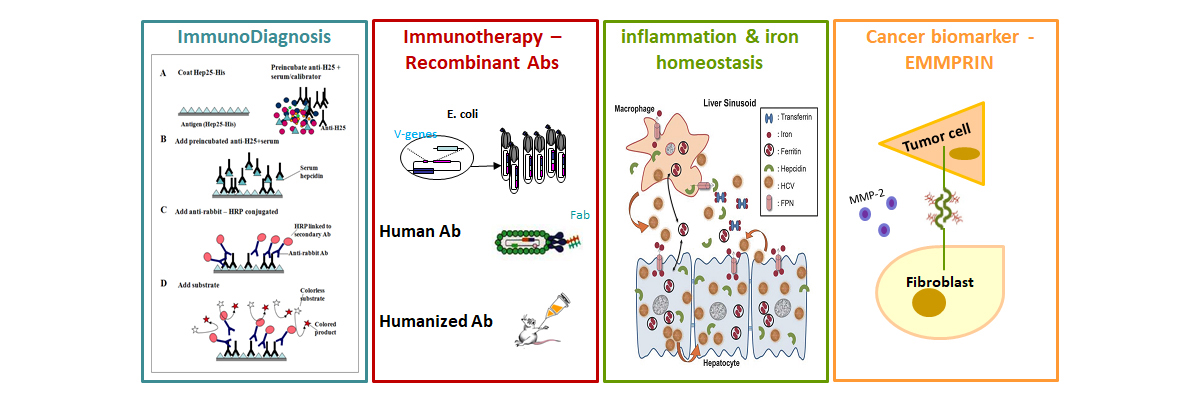
Το Εργαστήριο Μοριακής Βιολογίας και Ανοσοβιοτεχνολογίας εστιάζεται στην ανάπτυξη νέων βιοτεχνολογικών φαρμάκων με σκοπό τη μελέτη της λειτουργικότητας των ανασυνδυασμένων βιομορίων και των μοριακών στόχων για τη διάγνωση και θεραπευτική προσέγγιση διαφόρων νοσημάτων.
Η παραγωγή των ανασυνδυασμένων βιομορίων (αντιγόνα, αντισώματα και πεπτίδια) γίνεται σε ετερόλογα συστήματα έκφρασης (κύτταρα θηλαστικών, βακτήρια και ζυμομήκυτα).
Είναι το μοναδικό εργαστήριο στην Ελλάδα στο οποίο έχει αναπτυχθεί η τεχνολογία των «φάγων-αντισωμάτων» για την απομόνωση ανασυνδυασμένων ανθρώπινων αντισωμάτων και την ανθρωποποίηση μονοκλωνικών αντισωμάτων.
Η ερευνητική δραστηριότητα του εργαστηρίου (αναλυτικότερα στο αγγλικό κείμενο) επικεντρώνεται σήμερα στην:
Aνοσοθεραπεία του καρκίνου
- Μελέτη της EMMPRIN στην επαγωγή MMP-2.
- Απομόνωση ανθρώπινων αντισωμάτων έναντι της EMMPRIN
- Μελέτη της έκφρασης της EMMPRIN από τον HCV στον ηπατοκυτταρικό καρκίνο (HCC) (σε συνεργασία με Ο. Γεωργοπούλου)
- Μελέτη νέων βιοδεικτών ηπατοκυτταρικού καρκίνου
Ηπατιδίνη (Hepcidin): Ο κύριος ρυθμιστής της ομοιόστασης του σιδήρου
- Ανάπτυξη ανασυνδυασμένης ηπατιδίνης και ειδικών mAbs για τη διάγνωση και θεραπευτική προσέγγιση ασθενειών με διαταραχή στην ομοιόσταση του σιδήρου.
- Εξουδετερωτικά αντισώματα έναντι της ηπατιδίνης σε πειραματικό μοντέλο φλεγμονής
- Προσδιορισμός και συσχέτιση επιπέδων ηπατιδίνης σε ασθενείς με διαταραχές στην ομοιόσταση του σιδήρου
- Μηχανισμός ρύθμισης της ηπατιδίνης στα ηπατοκύτταρα που έχουν μολυνθεί in vitro από τον HCV (σε συνεργασία με Ο. Γεωργοπούλου)
Χρηματοδοτήσεις 2011-2017:
- ΕΤΠΑ/ΕΣΠΑ 2007-2013 – ΠΡΟΓΡΑΜΜΑ ΣΥΝΕΡΓΑΣΙΑ, 2010-2013
547.200 ευρώ Ανάπτυξη αυτοματοποιημένων μεθόδων προσδιορισμού της ηπατιδίνης και διερεύνηση του διαγνωστικού και παθογενετικού της ρόλου σε ασθένειες απορρύθμισης της ομοιοστασίας του σιδήρου. Συντονίστρια: Α. Μαμαλάκη Συνεργάτες: Ο. Γεωργοπούλου (ΕΙΠ), Γ. Σίμος (ΙΒΕΤ), Μπαϊρακτάρη Ε. (Παν/μιο Ιωαννίνων), Medicon SA. - Ίδρυμα Λάτση, 2011
12.000 euro Μελέτη του καρκινικού αντιγόνου EMMPRIN και απομόνωση ανθρώπινων θεραπευτικών αντισωμάτων - ACIP, 2012
10.380 euro. Title: Viral Antigen Targeting by Genetically Engineered Chimeric Molecules Συνεργάτες: A. Tchorbanov (Bulgarian Academy of Sciences, Sofia), A. Pierangeli, PhD. (Sapienza University of Rome). - ΕΤΠΑ/ΕΣΠΑ 2007-2013 – Δράση «ΑΝΑΠΤΥΞΙΑΚΕΣ ΠΡΟΤΑΣΕΙΣ ΕΡΕΥΝΗΤΙΚΩΝ ΦΟΡΕΩΝ – ΚΡΗΠΙΣ» 2012-2015 ΓΓΕΤ,
Λοιμώδη και νευροεκφυλιστικά νοσήματα στον 21ο αιώνα: από τη μελέτη των βασικών μηχανισμών στην ανάπτυξη μεταφραστικής έρευνας και μεθοδολογιών αιχμής με στόχο τη διάγνωση, την πρόληψη και τη θεραπεία - ΥΠΟΤΡΟΦΙΕΣ ΑΡΙΣΤΕΙΑΣ IKY ΓΙΑ ΜΕΤΑΔΙΔΑΚΤΟΡΙΚΕΣ ΣΠΟΥΔΕΣ ΣΤΗΝ ΕΛΛΑΔΑ-ΠΡΟΓΡΑΜΜΑSIEMENS 2014-2016
31.800 euro Μελέτη νέων βιοδεικτών ηπατοκυτταρικού καρκίνου Φορέας υποδοχής: ΕΙΠ (ΕΥ: Δρ. Α. Μαμαλάκη) Μεταδιδακτορικός Συνεργάτης: Δρ. Α. Δημητριάδης
- Production of recombinant fragments of muscle acetylcholine receptor and their use for ex vivo immunoadsorption of anti-ACh receptor antibodies from myasthenic patients. Tzartos, S.J., Psaridi-Linardaki, L., Kostelidou, K. and Mamalaki. A. EP1509605 (B1)
- Process for producing hepcidin A. Mamalaki, M. Marinou, V. Koliaraki. US8614068 (B2)
- Methods for Treating Neoplasia. K. Sidera, A. Mamalaki, L. Patsavoudi. US9328161 (B2) AU2011310664 (B2)
2021
Foka P, Dimitriadis A, Karamichali E, Kochlios E, Eliadis P, Valiakou V, Koskinas J, Mamalaki A, Georgopoulou U. 2022. HCV-Induced Immunometabolic Crosstalk in a Triple-Cell Co-Culture Model Capable of Simulating Systemic Iron Homeostasis. Cells. Aug 30;10(9):2251. (I.F. 6,6) doi: 10.3390/cells10092251
Dimitriadis A, Foka P, Kyratzopoulou E, Karamichali E, Petroulia S, Tsitoura P, Kakkanas A, Eliadis P, Georgopoulou U, Mamalaki A. 2020 The Hepatitis C virus NS5A and core proteins exert antagonistic effects on HAMP gene expression: the hidden interplay with the MTF-1/MRE pathway. FEBS Open Bio. Jan;11(1):237-250 (I.F. 2,693). doi: 10.1002/2211-5463.13048
Vaia Valiakou, Petros Eliadis, Eirini Karamichali, Ourania Tsitsilonis, John Koskinas, Urania Georgopoulou, and Pelagia Foka. 2021 Differential Expression of the Host Lipid Regulators ANGPTL-3 and ANGPTL-4 in HCV Infection and Treatment, Int J Mol Sci. Jul 26;22(15):7961. doi: 10.3390/ ijms22157961.
2018
Ivanova II, Mihaylova NM, Manoylov IK, Makatsori D, Lolov S, Nikolova MH, Mamalaki A, Prechl J, Tchorbanov AI. 2018 Targeting of Influenza Viral Epitopes to Antigen-Presenting Cells by Genetically Engineered Chimeric Molecules in a Humanized NOD SCID Gamma Transfer Model. Hum Gene Ther. Sep;29(9):1056-1070. (IF: 5.695) doi: 10.1089/hum.2018.100
Molyvdas A, Georgopoulou U, Lazaridis N, Hytiroglou P, Dimitriadis A, Foka P, Vassiliadis T, Loli G, Phillipidis A, Zebekakis P, Germenis AE, Speletas M, Germanidis G. 2018 The role of the NLRP3 inflammasome and the activation of IL-1β in the pathogenesis of chronic viral hepatic inflammation. Cytokine. Oct; 110: 389-396. doi: 10.1016/j.cyto.2018.04.032
2016
Foka P, Dimitriadis A, Karamichali E, Kyratzopoulou E, Giannimaras D, Koskinas J, Varaklioti A, Mamalaki A, Georgopoulou U. Alterations in the iron homeostasis network: A driving force for macrophage-mediated hepatitis C virus persistency. Virulence. 2016 Aug 17;7(6):679-90.
2015
Lyberopoulou A, Chachami G, Gatselis NK, Kyratzopoulou E, Saitis A, Gabeta S, Eliades P, Paraskeva E, Zachou K, Koukoulis GK, Mamalaki A, Dalekos GN, Simos G. Low Serum Hepcidin in Patients with Autoimmune Liver Diseases. PLoS One. 2015 Aug13;10(8):e0135486.
Kitsati N, Liakos D, Ermeidi E, Mantzaris MD, Vasakos S, Kyratzopoulou E, Eliadis P, Andrikos E, Kokkolou E, Sferopoulos G, Mamalaki A, Siamopoulos K, Galaris D. Rapid elevation of transferrin saturation and serum hepcidin concentration in hemodialysis patients after intravenous iron infusion. Haematologica. 2015 Mar;100(3):e80-3.
2014
Foka P, Dimitriadis A, Kyratzopoulou E, Giannimaras DA, Sarno S, Simos G, Georgopoulou U, Mamalaki A. A complex signaling network involving protein kinase CK2 is required for hepatitis C virus core protein-mediated modulation of the iron-regulatory hepcidin gene expression. Cell Mol Life Sci. 2014 Nov;71(21):4243-58.
Georgopoulou U, Dimitriadis A, Foka P, Karamichali E, Mamalaki A. Hepcidin and the iron enigma in HCV infection. Virulence. 2014 May 15;5(4):465-76.
2013
Papadimitropoulou A, Mamalaki A. The glycosylated IgII extracellular domain of EMMPRIN is implicated in the induction of MMP-2. Mol Cell Biochem. 2013 Jul;379(1-2):107-13.
2012
Rentoukas E, Tsarouhas K, Kaplanis I, Korou E, Nikolaou M, Marathonitis G, Kokkinou S, Haliassos A, Mamalaki A, Kouretas D, Tsitsimpikou C. Connection between telomerase activity in PBMC and markers of inflammation and endothelial dysfunction in patients with metabolic syndrome. PLoS One. 2012;7(4):e35739.
2011
Sidera K, El Hamidieh A, Mamalaki A, Patsavoudi E. The 4C5 cell-impermeable anti-HSP90 antibody with anti-cancer activity, is composed of a single light chain dimer. PLoS One. 2011;6(9):e23906.
Lioupis C, Barbatis C, Drougou A, Koliaraki V, Mamalaki A, Klonaris C, Georgopoulos S, Andrikopoulos V, Bastounis E. Association of haptoglobin genotype and common cardiovascular risk factors with the amount of iron in atherosclerotic carotid plaques. Atherosclerosis. 2011 May;216(1):131-8.
2010
Gattenlöhner S, Jörissen H, Huhn M, Vincent A, Beeson D, Tzartos S, Mamalaki A, Etschmann B, Muller-Hermelink HK, Koscielniak E, Barth S, Marx A. A human recombinant autoantibody-based immunotoxin specific for the fetal acetylcholine receptor inhibits rhabdomyosarcoma growth in vitro and in a murine transplantation model. J Biomed Biotechnol. 2010;2010:187621.
Tsochatzis E, Papatheodoridis GV, Koliaraki V, Hadziyannis E, Kafiri G, Manesis EK, Mamalaki A, Archimandritis AJ. Serum hepcidin levels are related to the severity of liver histological lesions in chronic hepatitis C. J Viral Hepat. 2010 Nov;17(11):800-6.
Lekka E, Gritzapis AD, Perez SA, Tsavaris N, Missitzis I, Mamalaki A, Papamichail M, Baxevanis CN. Identification and characterization of a HER-2/neu epitope as a potential target for cancer immunotherapy. Cancer Immunol Immunother. 2010 May;59(5):715-27.
2009
Kroot JJ, Kemna EH, Bansal SS, Busbridge M, Campostrini N, Girelli D, Hider RC, Koliaraki V, Mamalaki A, Olbina G, Tomosugi N, Tselepis C, Ward DG, Ganz T, Hendriks JC, Swinkels DW. Results of the first international round robin for the quantification of urinary and plasma hepcidin assays: need for standardization. Haematologica. 2009 Dec;94(12):1748-52.
Dimitriadis A, Gontinou C, Baxevanis CN, Mamalaki A. The mannosylated extracellular domain of Her2/neu produced in P. pastoris induces protective antitumor immunity. BMC Cancer. 2009 Oct 30;9:386.
Koliaraki V, Marinou M, Vassilakopoulos TP, Vavourakis E, Tsochatzis E, Pangalis GA, Papatheodoridis G, Stamoulakatou A, Swinkels DW, Papanikolaou G, Mamalaki A. A novel immunological assay for hepcidin quantification in human serum. PLoS One. 2009;4(2):e4581.
2008
Koliaraki V, Marinou M, Samiotaki M, Panayotou G, Pantopoulos K, Mamalaki A. Iron regulatory and bactericidal properties of human recombinant hepcidin expressed in Pichia pastoris. Biochimie. 2008 May;90(5):726-35.
2006
Belimezi MM, Papanastassiou D, Merkouri E, Baxevanis CN, Mamalaki A. Growth inhibition of breast cancer cell lines overexpressing Her2/neu by a novel internalized fully human Fab antibody fragment. Cancer Immunol Immunother. 2006 Sep;55(9):1091-9
2005
Papadodima O, Sergaki M, Hurel C, Mamalaki A, Matsas R. Characterization of the BM88 promoter and identification of an 88 bp fragment sufficient to drive neurone-specific expression. J Neurochem. 2005 Oct;95(1):146-59.
Protopapadakis E, Kokla A, Tzartos SJ, Mamalaki A. Isolation and characterization of human anti-acetylcholine receptor monoclonal antibodies from transgenic mice expressing human immunoglobulin loci. Eur J Immunol. 2005 Jun;35(6):1960-8.
Psaridi-Linardaki L, Trakas N, Mamalaki A, Tzartos SJ. Specific immunoadsorption of the autoantibodies from myasthenic patients using the extracellular domain of the human muscle acetylcholine receptor alpha-subunit. Development of an antigen-specific therapeutic strategy. J Neuroimmunol. 2005 Feb;159(1-2):183-91
Fostieri E, Tzartos SJ, Berrih-Aknin S, Beeson D, Mamalaki A. Isolation of potent human Fab fragments against a novel highly immunogenic region on human muscle acetylcholine receptor which protect the receptor from myasthenic autoantibodies. Eur J Immunol. 2005 Feb;35(2):632-43.


